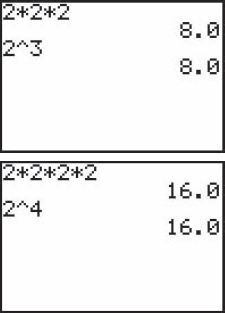1.5. Powers and Roots
Now that we know how to do the four basic arithmetic operations on signed and approximate numbers, let us learn how to find powers and roots.
1.5.1. Powers
▪ Exploration:
Try this. Use your calculator to multiply 2 × 2 × 2. Then use it to evaluate 23. You can do this using the ![]() key on your calculater, as shown on the screen. Then evaluate 2 × 2 × 2 × 2, as well as 24.
key on your calculater, as shown on the screen. Then evaluate 2 × 2 × 2 × 2, as well as 24.
Can you summarize what you have found?
In the expression
- 24
the number 2 is called the base, and the number 4 is called the exponent. The expression is read "two to the fourth power." Its value is
- 24 2 · 2 · 2 · 2 = 16
To square a number means to raise it to the power 2. To cube a number means to raise it to the power 3.

TI-83/84 screens for the Exploration.
|
TEACHING TIP: Emphasize that the base is multiplied, not added. Thus 23 = 2(2)(2) = 8, not 2 + 2 + 2 = 6. |
Stated as a formula,
NOTE
![]()
Example 47:
|
When raising an approximate number to a power, round your answer to the number of significant digits in the base, not the exponent.
TI-83/84 screen for Example 48.
Example 48:Use your calculator to verify the following: ... |
Get Technical Mathematics, Sixth Edition now with the O’Reilly learning platform.
O’Reilly members experience books, live events, courses curated by job role, and more from O’Reilly and nearly 200 top publishers.

